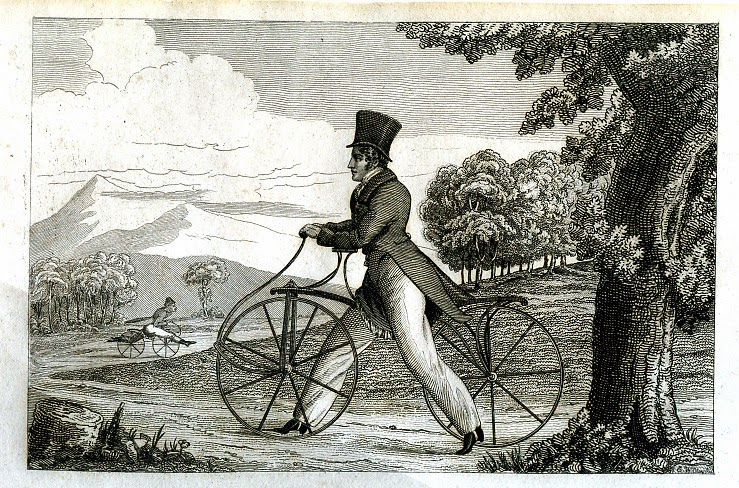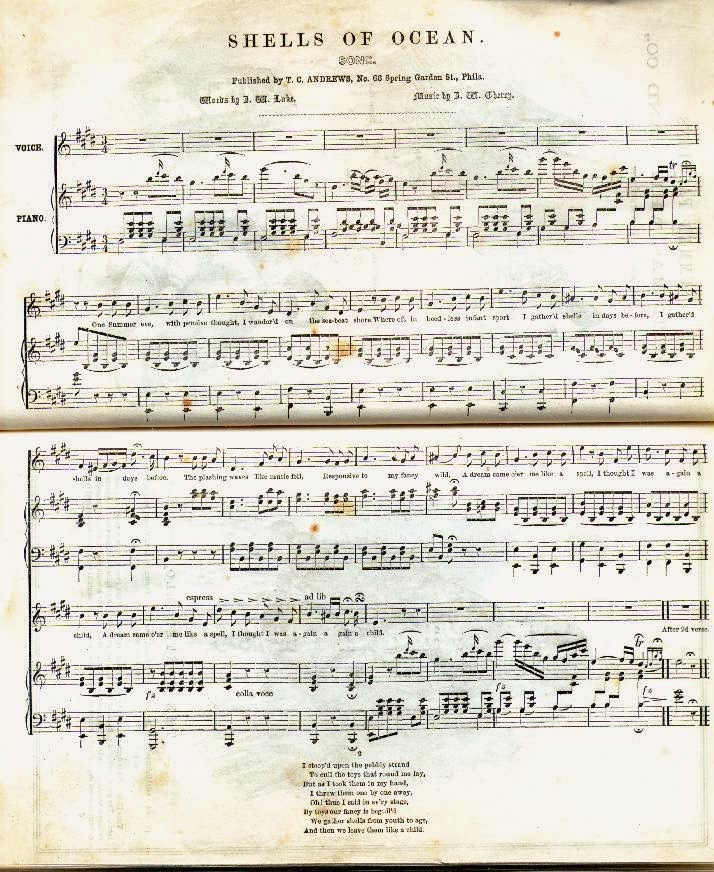Daisy Daisy,
Give me your answer do!
I'm half crazy,
All for the love of you!
It won't be a stylish marriage,
I can't afford a carriage,
But you'll look sweet on the seat
Of a bicycle built for two !
Tre incantevoli fotografie d'epoca che ritraggono altrettanti modelli di biciclette per due, concepite tra il 1886 ed il 1890, per introdurre l'argomento ed accompagnare i versi della canzone che Henry Dacre compose nel 1892, quando ormai la bicicletta era uno spettacolo quasi quotidiano di cui godere nelle città tardo vittoriane: si tratta di una canzone che divenne immensamente popolare, sia nei locali pubblici di Londra che in quelle d'oltremare il cui testo tratta di un tandem - una bicicletta fatta per due - e la Daisy in questione si suppone fosse la contessa di Warwick, Frances Evelyn 'Daisy' Greville,
Daisy Greville ritratta nel 1890
Era l'inizio del secolo, esattamente il gennaio del 1818 quando in Germania, a Mannheim il barone Karl Drais brevettò la Laufmaschine termine che in tedesco significa velocipede
- pedestrian curricle verrà definito in inglese - una simpaticissima bicicletta con un manubrio particolare, fatto per appoggiarvisi il petto onde farvi forza per potenziare la spinta delle gambe, poichè il velocipede, come si intuisce dal termine stesso, si valeva non ancora di pedali per muoversi, bensì dei piedi .... su di esso, in pratica, si correva seduti, tanto per intenderci !
Un anno dopo, la versione inglese fu brevettata da Denis Johnson e divenne al tempo davvero una mania nonostante Keats ebbe a definirla 'il nulla del giorno'; era considerato il cavallo dei dandies in quanto erano spesso i frivoli giovani del tempo a guidarla e Keats aveva ragione quando ipotizzava che la sua popolarità sarebbe stata di breve durata: la costante spinta lungo il terreno logorava velocemente le suole degli stivali dei 'signorini', che spesso venivano fermati mentre sfrecciavano pericolosamente ai lati delle strade e multati due pounds, una somma decisamente considerevole considerato che stiamo parlando dei primi anni del 1800.
La prima macchina a pedale si crede sia stato costruito nel 1839 dal fabbro scozzese, Kirkpatrick MacMillan ma fu solamente nel 1861 che il produttore di carrozze francese, Pierre Michaux, inventò la prima bicicletta che aveva i pedali direttamente collegati alla ruota anteriore; non credo fosse molto comoda da guidare tanto che venne soprannominata Boneshaker ( letteralmente scuoti - ossa )
a causa delle terribili vibrazioni causate dal fatto che le ruote di legno erano avvolte da cerchi di ferro e le strade erano ancora tutte completamente sterrate, dissestate e notevolmente sassose.
Ad essa subentrò perciò il modello denominato High Wheeler o Penny Farthing,
in cui la ruota anteriore ruota molto più grande della posteriore tentava di ovviare al disagio dello scuotimento consentendo anche le ampie dimensioni della stessa di non entrare nelle buche che sovente erano presenti sulle strade; dal 1870 al 1890 questi veicoli crebbero notevolmente in popolarità perchè consentiva di muoversi più velocemente che per mezzo del cavallo ed offriva una maggiore libertà per chi abitava in città.
Inutile dire che la bicicletta, così concepita, continuava a rimanere un mezzo di locomozione scomodo e persino malsicuro fino a che nel 1885 John Kemp Starley, nipote di James, concepì con successo la safety bicycle, la 'bicicletta sicura' conosciuta come Rover, che mai fu brevettata, caratterizzata da due ruote di eguali dimensioni, di cui quella anteriore sterzante, con una catena dentellata che consentiva la trasmissione del movimento alla ruota posteriore.
Diffusa con enorme successo sia nel Nord America che nel vecchio continente, la "safety bicycle" soppiantò definitivamente i modelli precedenti, ancor più quando solamente tre anni più tardi John Dunlop pensò di rivestire le ruote con una camera d'aria per attutire le vibrazioni originate dall'irregolarità del selciato.
In epoca edoardiana, l'hobby del ciclismo divenne molto popolare, soprattutto presso il pubblico femminile,
Un 'cycling club' della fine del XIX secolo
Edwardian ladies in 1906
tanto che venne creata una linea di abbigliamento appositamente studiata per conciliare i dettami della moda del tempo con l'esigenza di muovere le gambe per articolare i pedali:
la biancheria intima constava di una gonna pantalone, e così pure l'abito
e per rendere tutto ancor più semplice ed agevole Amelia Bloomer (1818 - 1894) creò un modello di pantaloni prettamente femminili adatti per praticare ogni tipo di attività sportiva per la nuova donna edoardiana, la Gibson Girl
( se ancora non lo avete letto vi suggerisco il post di My little old world in cui ne trattai: http://sweetlydreamingofthepast.blogspot.it/2014/05/charles-dana-gibson-e-lideale.html )
Bambola di carta con abiti per ciclismo
... ma di Amelia Bloomer e del Bloomerism vi parlerò in una delle prossime occasioni !
Miei carissimi ed affezionati compagni di viaggio, questi nostri appuntamenti sono sempre più entusiasmanti e preziosi per me, vi lascio con un abbraccio colmo di affetto e di gratitudine... e con le note della canzone DAISY BELL che mi ha ispirato questo mio scritto.
click
A presto ♥
- picture 1
Daisy Daisy,
Give me your answer do!
I'm half crazy,
All for the love of you!
It won't be a stylish marriage,
I can't afford a carriage,
But you'll look sweet on the seat
Of a bicycle built for two !
- picture 2
- picture 3
Three charming vintage photographs depicting a few models of bicycles for two, belonging to the years between 1886 and 1890, to introduce this topic and accompany the lyrics of the refrain of the song which in 1892 Henry Dacre wrote, when the bicycle was an almost daily sight of which enjoy in the late Victorian cities: it is a song that became immensely popular, both in music halls of London that in those overseas, the text of which is about a tandem - a bicycle made for two - and the Daisy in question is supposed to be the Countess of Warwick, Frances Evelyn 'Daisy' Greville,
- picture 4 - Daisy Greville portrayed in 1890
charming woman known for being actively involved in the struggle for women's rights as well as to be the mistress of the Prince of Wales ... and we, who have a romantic soul, with pleasure accept this version, although it seems not strongly supported by secure evidence, and make it our own!
It was the beginning of the century, exactly January 1818 when in Mannheim, Germany, Baron Karl Drais patented the Laufmaschine term which in German means velocipede
- picture 5
- Pedestrian curricle it'll be defined in English - a very nice bike with a particular handlebar, made to lean against one's chest in order to force it and to increase the thrust of the legs, as the velocipede, as you can imagine from the term itself, moved thanks to one's feet .... on it, in practice, people ran sitting, so to speak!
A year later, the English version was patented by Denis Johnson and became a craze of the time in spite Keats had to call it 'the nothingness of the day'; it was considered the dandies's horse as they were often such frivolous youth to ride it and Keats was right when he suggested that its popularity was short-lived: the constant push along the ground quickly wore out the soles of the boots of these 'gentlemen', which were often stopped while darting dangerously to the side of the road and fined two pounds, a very substantial sum considering that we are talking about the early 1800's.
The first foot machine is believed to have been built in 1839 by the Scottish blacksmith Kirkpatrick MacMillan, but it was only in 1861 that the French manufacturer of carriages, Pierre Michaux, invented the first bicycle that had the pedals attached directly to the front wheel; I think it wasn't very comfortable to drive in fact it was nicknamed Boneshaker
- picture 6
because of the terrible vibrations caused by the fact that the wooden wheels were wrapped by iron hoops and the streets were still all completely unpaved, bumpy and considerably rocky.
- picture 7
So it took over the model called High Wheeler or Penny Farthing,
- picture 8
- picture 9
in which the front wheel much larger than the rear one attempting to remedy the discomfort of the shaking also because of the large size of the wheel that didn't easily enter in the holes that were often present on the roads; during the years 1870-1890 these vehicles grew greatly in popularity because they allowed to move faster than by horse and offered more freedom for those who lived in the city.
Needless to say that bikes, so conceived, continued to remain a means of locomotion uncomfortable and even unsafe until in 1885 John Kemp Starley, grandson of James, conceived a successful safety bicycle also known as Rover, which was never patented, characterized by two wheels of equal size, of which the front one steerable, with a toothed chain which allowed the transmission of the movement to the rear wheel.
Spread with enormous success both in North America than in the old continent, the safety bicycle definitively supplanted the previous models, especially when only three years later John Dunlop thought to coat the wheels with an air chamber to absorb vibrations arising by the irregularity of the paving.
In the Edwardian era, the hobby of cycling became very popular, especially among the female people,
- picture 10 - A 'cycling club' of the late XIXth century
- picture 11 - Edwardian ladies portrayed in 1906
so much so that it was created a line of clothing specifically designed to reconcile the dictates of the fashion of the time with the need to move legs to articulate the pedals:
- picture 12
the underwear consisted of a divided skirt, and so was the gown
- picture 13
- picture 14
and to make things even more simple and easy Amelia Bloomer (1818 - 1894) created a model of purely feminine pants suitable for every kind of sporting activity for the new Edwardian woman, the Gibson Girl ( If you haven't already read it I suggest you the post from My little old world in which I treated about it
- picture 15 - Paper doll with suits for cycling
- picture 16
But... about Amelia Bloomer and Bloomerism I'm going to tell you in a future occasion !
My dear and precious traveling companions, these appointments of ours are always more and more exciting and valuable for me, I leave you with a hug full of love and gratitude ... and with the DAISY BELL notes, the song that inspired me my writing.
See you soon ♥
























































%2B-.%2BTucker%2B(1800%E2%80%99s).jpg)






